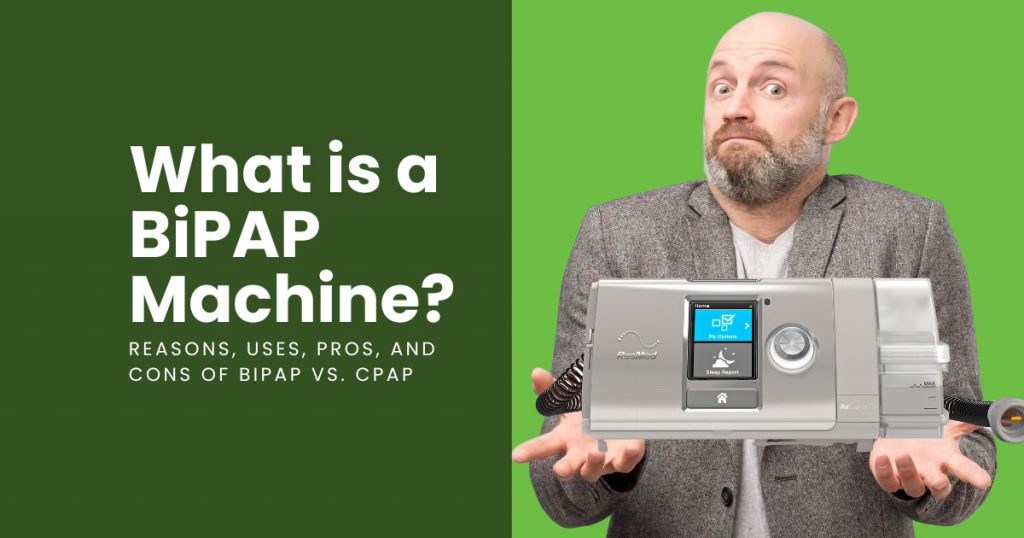
In the past, we’ve discussed how a CPAP works and the ways that it can reverse the effects of sleep apnea. But what if you need more support than CPAP can provide? This is where BiPAP comes into play!
So, what is a BiPAP machine?
A BiPAP, also called a Bi-level positive airway pressure machine, is a device that utilizes positive airway pressure to provide respiratory support. The name comes from its use of bi-level technology, which offers two different air pressure settings to assist you while breathing in and while breathing out.
Doctors often prescribe BiPAP for individuals who have COPD or have advanced and/or non-obstructive sleep apnea. Your provider may suggest BiPAP if you have previously tried CPAP but struggled to exhale against the continuous flow of pressurized air.
In this article, we’ll go over all the ins and outs of BiPAP. We’ll explain how and why this technology works so well, as well as discuss who is most likely to benefit from the use of a BiPAP machine.
We’ll explore the benefits of these devices and provide you with solutions for some of the drawbacks that may be associated with their use. Additionally, we will review the differences between BiPAP and CPAP, plus answer some of the most commonly asked questions regarding BiPAP and its use.
What is BiPAP?
If you’ve done any reading on CPAP and sleep apnea, you’ve probably noticed the commonly used acronym PAP. It stands for positive airway pressure. This is a method of ventilation that focuses on “pushing” the flow of oxygen down the airway and into the lungs. It helps to prevent the airway from becoming obstructed while providing the lungs with additional air support.
There are three main types of machines that utilize positive airway pressure:
- CPAP: CPAP maintains a consistent flow of air, which is set to one pre-selected level of pressure throughout the entire respiratory cycle.
- APAP: APAP features auto-adjusting technology, which monitors your respirations for signs of struggle or improvement and makes automatic changes to the amount of air pressure being applied based on your breathing patterns.
- BiPAP: BiPAP utilizes bi-level technology, which switches back and forth between two separate air pressure settings, depending on whether you are breathing in or out.
While they share similarities, BiPAP machines differ greatly from the air pressure technology found in CPAP and APAP. That is because CPAP and APAP devices both maintain a single level of pressure throughout both the inhalation and exhalation phases of breathing.
Although it can be used to manage many of the same conditions as the other two PAP devices, doctors tend to prescribe BiPAP less often. This is primarily because BiPAP offers more support than is typically needed to treat the average case of obstructive sleep apnea. That said, studies show that BiPAP is just as, if not more, effective than its counterparts. This is especially true for individuals who struggle with breathing out for one reason or another.
How Does BiPAP Improve Breathing?
In just a moment, we’ll dive into the reason why BiPAP works so well. But before we do, let’s go over the basics of breathing, plus why some breathing issues are more likely to occur when you’re sleeping.
Your Lungs Act Like a Vacuum
To understand how BiPAP treats sleep apnea and related conditions, let’s take a moment to briefly go over the basics of how we breathe, along with the role that air pressure plays throughout this process.
The first thing you need to know is that your brain has a system that automatically controls your breathing. This is why you don’t have to remind yourself to take each breath. That said, you do have the ability to take control of when and how you breathe. This is why you are able to hold your breath or take extra breaths when needed.
The act of breathing consists of two phases:
- Inhalation: When it’s time to inhale, your chest muscles cause your lungs to expand. This allows the air particles inside to spread out more, causing the air pressure in your lungs to decrease. This creates a vacuum-like effect, so the air outside your body is quickly sucked into your lungs.
- Exhalation: As your body senses that it is time to breathe out, your chest muscles begin to relax. Your lungs shrink back to their original size, pushing the air particles inside closer together. This causes the pressure in your chest to rise, meaning the vacuum becomes reversed. As a result, the old air is pushed out of your lungs.
Sleep Can Complicate the Breathing Process
As you sleep, breathing can be impacted by a number of factors, including:
- Sleeping Position: Certain sleeping positions can make it harder to breathe, especially for individuals with certain conditions such as pregnancy, COPD, congestive heart failure, obesity, or illness. Sleeping in some positions may also make airway obstruction more likely.
- Nervous System: Your nervous system plays a vital role in maintaining your breathing. Although you may not be consciously aware of it, your brain is responsible for telling your body when and how to breathe. In people with central sleep apnea, it is unable to send the correct signal to the muscles involved in breathing while you sleep.
- Muscle Function: When you sleep, the muscles in your body tend to relax even more than they do during the day. For some people, this can cause breathing issues. For example, the muscles in your throat and tongue can relax so much that they block your airway. Or the muscles in your chest may be unable effectively expand your lungs.
BiPAP Supports Breathing and Maintains the Airway
Doctors may not prescribe BiPAP as often, but that doesn’t mean it isn’t effective. So, what is a BiPAP machine’s defining feature? In short, it’s the bi-level air pressure system.
During the inhalation stage, the delivery of higher-pressure air helps to fill the lungs with air while supporting the airway. When it’s time to exhale, the BiPAP device lowers the amount of air pressure rather than maintaining the same amount throughout, as it would with CPAP. There are a few benefits to utilizing different levels of positive air pressure during both phases of breathing.
- More Air Gets Into the Lungs During Inhalation: When the air that is breathed in is highly pressurized, it increases the amount of air that goes into the lungs. This is due to the increased difference between the air pressure outside versus inside the lungs. This improves the quality of each breath, which is particularly important for those with conditions that make breathing very difficult.
- Your Airway Is Supported: The flow of highly pressurized air acts as a stabilizing force for the airway during inhalation. However, it is also possible for a partial airway collapse to occur during exhale. Because BiPAP machines continue the flow of pressurized air during exhale, the airway remains stable. This is thanks to the pressure combination of air coming out of the lungs versus air coming in from the upper airway.
- Exhalation Requires Less Effort: Like inhaling, the process of exhaling is largely dependent on the difference in air pressure inside of the lungs compared to the pressure outside. So when you are exposed to highly pressurized airflow when trying to breathe out, it can be incredibly difficult to do so. This is why the BiPAP machine switches over to a lower air pressure setting for exhalation. The decrease in pressure is enough that used air can easily be pushed out without losing support for the airway.
Like other PAP devices, the pressurized air is delivered via a mask that covers the mouth and/or nose. The machine and mask can both be adjusted to suit the individual’s breathing patterns, sleeping position, and other needs.
Is BiPAP Technology Effective?
PAP devices of all kinds are highly effective thanks to the simple but efficient method of using air pressure to maintain a person’s airway. BiPAP is especially skilled at supporting respirations in individuals who have complex breathing issues that make exhaling difficult as well as inhaling.
In one North African study completed in 2021, the health outcomes of dozens of obese people were documented following hospitalization and diagnosis of acute respiratory failure caused by a build-up of carbon dioxide in the lungs. Researchers found that BiPAP was effective not only while participants were in the hospital but also after discharge.
Of the people who were able to go home, nearly 60% were placed on BiPAP, more than 37% were sent home with a CPAP machine, and just over 2% did not use any sort of related therapy. Those individuals proved to have a survival rate of over 90% following one year after first being discharged.
Which Conditions Are Treated by BiPAP Machines?
BiPAP machines are used to treat a number of conditions. And while they can target many of the same conditions as CPAPs, these devices are typically reserved for individuals who have an especially difficult time inhaling and exhaling. For example, people with severe sleep apnea or COPD.
Some of the conditions that BiPAP has been used to treat are:
- Obstructive Sleep Apnea: Obstructive sleep apnea occurs when the muscles in the airway are weakened, causing the airway to partially collapse during sleep. People with OSA benefit from the airway support that is provided by the pressurized air used with BiPAP. The high-level air pressure during inhalation is particularly important, as it is during inhalation that the OSA airway is thought to be the least stable.
- Central Sleep Apnea: CSA arises when the brain is unable to consistently send signals to the muscles involved in breathing during sleep. This results in the affected individual being unable to maintain a regular breathing pattern. With BiPAP, the bi-level airflow encourages the lungs to maintain a regular breathing pattern. Some BiPAP machines can also initiate a breath on a predetermined basis for greater respiratory support.
- Complex Sleep Apnea: This condition arises when a person who has been prescribed a PAP device for OSA develops central sleep apnea. In such cases, BiPAP is helpful because it can prevent obstructions while supporting regular respiration.
- Chronic Obstructive Pulmonary Disorder: COPD causes inflammation throughout the airway and lungs. The effects are particularly bad in the tiny air sacs where oxygen and carbon dioxide are exchanged. BiPAP can help maintain the airways of people with COPD while also making it easier to inhale new air and exhale old air.
- Congestive Heart Failure: People with congestive heart failure experience a slew of symptoms caused by the heart’s inability to effectively pump enough blood to maintain the rest of the body’s needs. One side effect is difficulty breathing due to the buildup of fluids in the lungs. BiPAP can lessen breathing difficulties experienced by people with CHF.
- Acute Respiratory Failure: This condition occurs when a person’s respiratory system is suddenly unable to supply the body with oxygen or remove carbon dioxide. People who develop acute respiratory failure experience a sudden and severe inability to breathe regularly. Studies show that BiPAP is helpful in reducing respiratory stress in individuals with ARF.
Pros and Cons of BiPAP Machines
Doctors often prescribe BiPAP for people who have qualifying conditions. And in those cases, it can be life-changing. That said, these devices occasionally come with side effects that you should be aware of.
Benefits of Using BiPAP
There are many benefits that come with using BiPAP. For one, it reduces your risk for complications that have been proven to arise from untreated (or undertreated) sleep apnea. For example, when left unaddressed, sleep apnea has been linked to chronic inflammation and cardiovascular disease. Additionally, BiPAP may be more effective than CPAP for people who have difficulty exhaling against the pressure of the machine.
If you have a disorder that impacts your breathing while you sleep, the benefits of BiPAP could include the following:
- Better Sleep Quality: People who have untreated sleep apnea and/or chronic respiratory conditions are much more likely to experience poor sleep.
- Increased Restfulness Upon Waking: Patients who are treated with PAP devices are much more likely to see an improvement in the amount of energy they feel upon waking up in the morning.
- Reduced Daytime Sleepiness: Left untreated, sleep apnea and other respiratory conditions have been linked to excessive daytime sleepiness. Studies suggest that treatment with PAP devices significantly improves the likelihood of daytime sleepiness.
- Lower Risk for Chronic Illness: Sleep apnea and other conditions which affect your breathing overnight have been associated with increased inflammation and other chronic conditions. Treatment with PAP machines decreases these risks.
- Improved Quality of Life: Non-invasive ventilation, including BiPAP, has been proven to improve quality of life.
Drawbacks of Using BiPAP
Sleeping with a BiPAP machine can truly be life-changing. That said, breathing through new equipment of any kind can take some getting used to. If your doctor has suggested that you try BiPAP, it’s important to remember that they have considered any potential drawbacks and believe that these changes will significantly improve your health and well-being.
Many of the concerns that can arise while sleeping with a BiPAP machine can easily be overcome by trial and error to find what works best for you while also maintaining good hygiene practices.
Here are some common issues that people who rely on BiPAP machines have mentioned in the past. Plus, we’ve included some tips for addressing them!
- Mask Discomfort: If you are new to PAP machines in general, practice wearing your mask before actually going to sleep at night. Make adjustments to the straps and mask cushion as needed. If necessary, you may want to invest in mask strap pads or strap covers.
- Skin Irritation: There are a couple of reasons why you may experience skin irritations from your BiPAP machine. Dirt and oil build-up can cause redness, acne, or even contact rashes. It’s important to regularly clean your mask to avoid this issue.
- Nasal Congestion: The flow of pressurized air can cause nasal dryness, which may lead to feelings of congestion. CPAP humidifiers can reduce the likelihood of this occurring. Additionally, you can also apply nasal moisturizer to treat any discomfort.
- Dry Mouth: Like nasal congestion, dry mouth is typically caused by the flow of pressurized air. This can be addressed by increasing the humidity of the air flowing through your CPAP.
None of these occurrences are unique to BiPAP, however, and there are many things you can do to combat these common side effects of CPAP therapy with the right planning, products, and accessories.
CPAP Versus BiPAP— What’s the Difference?
As we’ve previously touched on, the main difference between BiPAP and CPAP is the way in which the two machines deliver pressure throughout the inhalation and exhalation phases of breathing.
BiPAP delivers two different levels of positive air pressure. One that is higher during inspiration and one that is lower during expiration. Meanwhile, CPAP offers a continuous level of pressure through each breath.
When it comes to conditions that impact one’s ability to exhale, BiPAP may be more effective than CPAP. This is because the lower level of pressure reduces the amount of effort needed to push the air out of your lungs. However, CPAP is usually considered the first-line treatment for obstructive sleep apnea and other minor breathing issues, and the support it provides is often sufficient enough to not require the move to BiPAP.
| Feature | CPAP | APAP | BiPAP |
|---|---|---|---|
| Pressure | Constant | Auto-adjusting | Dual pressure |
| Inhale | Same as exhale | Auto-adjusting | Higher pressure |
| Exhale | Same as the setting for inhalation— can be reduced with pressure relief settings | Same as the setting for inhalation— can be reduced with pressure relief settings | Lower pressure |
| Treatment | Obstructive Sleep Apnea (OSA) | OSA, Central Sleep Apnea (CSA), Complex Sleep Apnea | OSA, CSA, COPD, Congestive Heart Failure, Pneumonia, Asthma Flare-up, Poor Breathing after Operation, Neurological Disease |
| Recommended for | Mild to severe OSA patients | Patients with varying types of sleep apnea | Patients with respiratory insufficiency, COPD, pneumonia, or other respiratory problems |
| Usage | Most common | More common | Least common |
| Cost | Least expensive | More expensive | Most expensive |
| Benefit | Keeps airway open and prevents pauses in breathing during sleep | Automatically adjusts pressure based on breathing patterns | Keeps airways open while providing more support for those with respiratory problems |
| Drawback | May cause discomfort due to constant pressure | May not be suitable for certain types of sleep apnea or breathing disorders | May cause discomfort due to higher pressure during inhalation. |
FAQs about BiPAP
What Is the Difference Between BiPAP and CPAP?
The main difference between BiPAP and CPAP is that BiPAP delivers two different levels of pressure for inhaling and exhaling, respectively. CPAP produces continuous pressure regardless of inhalation or exhalation. BiPAP may be more effective for people who need airway support but have difficulty exhaling against the high pressure of a CPAP machine.
How Do I Know if I Need a BiPAP Machine?
Before determining whether a BiPAP machine is right for you, your doctor will ask you some questions regarding your sleep health and will likely order a sleep study to determine whether you have a sleep disorder or some other condition that is affecting your breathing while you sleep.
If you have been diagnosed with sleep apnea or other respiratory disorder, your healthcare provider may recommend a BiPAP machine if other treatments have not been effective.
How Do I Use a BiPAP Machine?
To use your BiPAP machine, simply ensure the machine is on and plugged in, then put on your CPAP mask and adjust it so that it’s comfortable and not too tight. If you have a machine with an Auto On/Off function, take a couple of deep breaths to start your therapy. Otherwise, you’ll need to press the therapy start button on your device. Your BiPAP will automatically deliver your prescribed pressure for inhaling and a lower pressure for exhaling. Depending on your machine, it may also automatically adjust to your breathing pattern or deliver breaths on a timed basis.
Are There Any Side Effects of Using a BiPAP Machine?
Some people may experience discomfort or difficulty tolerating the mask and/or the flow or high-pressure air. People sometimes experience skin irritation, nasal congestion, or dry mouth. These side effects can often be managed by adjusting the mask or machine settings.
Is BiPAP Covered by Insurance?
BiPAP machines may or may not be covered by insurance. This depends on your specific insurance plan, along with what your doctor advises regarding your medical needs. It’s important to check with your insurance provider to determine your coverage and out-of-pocket costs.
Conclusion
If you struggle with sleep apnea but have also been diagnosed with other conditions which make breathing difficult, you may have been left frustrated after trying CPAP. If so, BiPAP may be right for you.
Let’s go over the key points regarding what is a BiPAP machine one more time!
A BiPAP machine is a type of device that provides positive airway pressure. It is used to treat complicated cases of sleep apnea, COPD, and other respiratory disorders. It delivers two levels of positive pressure to assist with breathing during sleep— a higher setting during inhalation and a lower pressure for exhalation.
While it has many benefits and can help you breathe easier while improving your sleep health, it can also be a bit uncomfortable and may take some getting used to. If you think you may need a BiPAP machine, talk to your healthcare provider. They can help you determine if BiPAP is right for you and assist you with getting the appropriate treatment.
Have you tried a positive airway pressure machine? Which one? Tell us about your experience in the comments!



